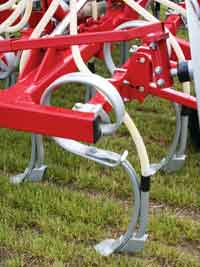Next-generation tine seed drills ready to go this season
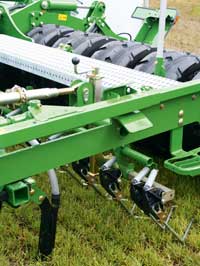
Improvements widen choice for tine users
When soils are thin and liberally peppered with stones, running disc coulters on the seed drill is only for those prepared to tolerate high maintenance bills.
Most growers in such circumstances, therefore, prefer a seeder with coulters that carve their way through such abrasive materials, using points on tines that are easy and relatively cheap to replace.
There is a compromise to tolerate, however: Inferior depth control is pretty much inherent with a coulter that can vibrate back and forth to absorb the impact of stones – although manufacturers have done much to keep that movement in a linear plane as far as possible and so limit variations in sowing depth to within reasonable limits.
Engineers at Amazone believe they have gone further than others with their latest seed drill, the Cayena. Instead of spring tines, the new seeder has rigid coulters, albeit attached to the square section cross-members of the steel frame by a mechanism that does allow some movement.
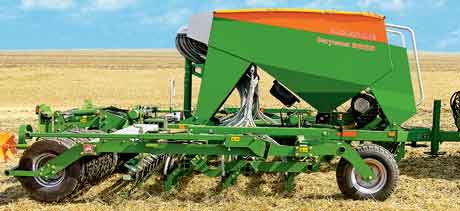
Amazone’s new Cayena tine drill is reckoned to be suitable for direct sowing into stubble on lighter soils, as well as for min-till and conventional seed-beds
“It’s obvious that a tine coulter is not going to give as good depth control as a disc coulter, but in the sorts of soils we see on the Cotswolds, on the Hampshire/Wiltshire Downs and elsewhere, tines are the best option,” says Simon Brown of Amazone.
“Also, with these marginal soils producing lower yielding crops, establishment costs need to be minimised and a tine drill will generally be cheaper to buy, maintain and run,” he adds. “One pass with a Catros fast, shallow disc cultivator followed by the Cayena operated by a tractor of 135hp or more should do the job.”
The Cayena’s tine design tackles the depth control compromise with an aggressive pull-in point on a relatively narrow rigid shank attached to the mainframe in the same way as the individual disc arms on the Catros and similar implements. An outsize square-section clamp with four round-section rubber spring inserts allow it to twist around the cross-member when the tine encounters a big stone.
“The coulters are arranged in three rows to allow decent trash flow with 166mm row spacing,” Mr Brown notes. “Together with the point design and high ‘spring’ resistance, this makes the capable of working direct into stubble on lighter soils, as well as into min-till and conventional seed-beds.”
A trailing tine harrow scuffles the surface level after the tine coulters have done their job, preparing the way for a row of 800mm diameter “wedge ring” packer tyres moulded to consolidate most effectively directly above the seed row. This design does press across the full width of the machine, however, with sufficient effect that no immediate follow-up rolling is needed.
“The packer tyres and a pair of wheels projecting from the front of the frame provide overall depth control for the semi-mounted implement, with central adjustment made using turnbuckles between the main frame and coulter frame,” Mr Brown explains. “Seed is delivered to outlets on the back of each coulter tine via tubes from a distribution ‘mushroom’ mounted outside the seed hopper.”
On the 6m model introduced first, hopper capacity is 2800 litres; a neat touch is the internal lighting that comes on with the tractor lights.
Electric seed metering unit drive provides infinitely variable sowing rates, a simple calibration procedure and automatic compensation for varying ground speed.
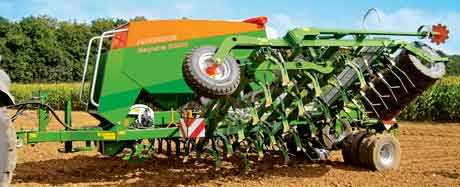
Centre-split folding frame of the 6m Cayena 6000 is supported in work on leading pair of wheels and a row of packer tyres – four of which are used for headland turns and road travel
Vibro Seeder adds min-till flexibility
|
|
|---|
| Vibro Seeder’s tines have separate spring, shank and point sections, plus a new design outlet and seed tube attached to the back of the shank |
New seed coulters feature on Kongskilde’s Vibro Seeder, which combines Nordsten seed metering and distribution systems with Kongskilde stubble cultivator design.
The Vibro Seeder is available in three configurations to suit different preferences and available tractors: Fully-mounted in 4m, 5m and 6m widths with an integral seed hopper or with a tractor front-mounted seed hopper in sizes up to 8m; and trailed in 6m and 8m widths with the same hopper.
“The Vibro Seeder is designed for minimum tillage seeding operations, offering flexibility, high capacity and low crop establishment costs,” says export director Henrik Lynge Jacobsen. “It is developed for sowing grain, peas, oilseed rape and similar crops, where the precision from a cultivator-drill combination is fully acceptable.”
The two hopper positions means growers can choose between a unit that is quick to attach and drop off, but concentrates its weight behind the tractor and one that spreads the weight front and rear.
The latter configuration does create a bulkier outfit that takes longer to dismantle, but it also has the further advantages that the coulter frame is unaffected by different amounts of seed in the hopper; the operator gets a clear view of and across the implement; and the coulter frame can be used alone as a cultivator.
Arranging the “S” tine coulters in four rows gives the drill generous trash clearance despite the 150mm row spacing, with depth control on mounted models provided by low pressure rubber tyres front and rear.
The resulting tilth is finished by one of two harrows – a vertical finger tine “Reekie” harrow and a cranked tine harrow for less stony soils. The trailed version – based on the Vibro Till 2800 stubble cultivator, which joined the Kongskilde range a couple of years ago – can be equipped with a twin crumbler roll, but otherwise there is no packing element for either configuration.
Seed distribution follows Nordsten’s usual practice of placing relatively small pneumatic dispersal heads, each serving eight coulters and fed by individual metering units, that are mounted on the coulter frame.
This not only leaves maximum space in the 1100-litre rear-mounted and 1500- or 1900-litre front-mounted hoppers but also positions the dispersal heads as close as possible to the coulters.
Metering roller drive is by landwheel through an infinitely variable gearbox.
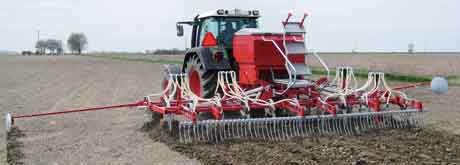
The Vibro Seeder can be had in rear-mounted integrated configuration or with the hopper carried on the front of the tractor feeding a rear-mounted or trailed coulter frame
Customer comments lead to Accord TS redesign
A comprehensive revamp of Kverneland’s Accord TS tine seeding drill has earned it the “Evo” tag.
The mounted unit is available in 4m to 6m fully-mounted sizes as before and the “C” tines held in place by leaf springs are unchanged. But just about every other aspect of the drill has been redesigned.
“Most of the changes are in direct response to customer comments,” says Kverneland seeding specialist Graham Owen. “Ease of operation and simplicity ensures the TS Evo remains a low-cost, low-maintenance drilling option for min-till and plough-based strategies. But, in a sense, it has come of age with this package of revisions.”
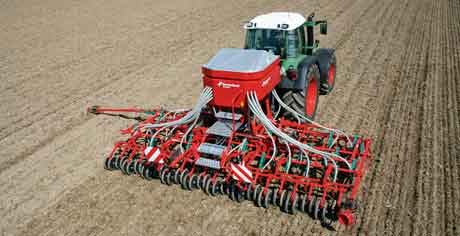
A larger capacity hopper with easier to adjustment metering system and a new three-section coulter frame are among differences between the original and Evo versions of the Kverneland TS flexible tine drill. The larger hopper has capacities of 1200, 1700 and 2200 litres
Adopting the larger hopper from the i-Drill Pro is one of the more obvious changes, which not only has up to 700 litres more seed capacity, but also is said to be easier to fill thanks to a fully-opening cover and easier to calibrate because of a metering system that needs no spanners or special tools to make adjustments.
Also obvious is the relocation of the depth wheels to within the frame, which Mr Owen says results in effective sowing depth control, and the change over from a two-section to a three-section frame said to result in better adaptation to surface contours.
“With drive to the metering mechanism now taken from one of the centre-section depth wheels, there is no need to disconnect the drive shaft before folding the coulter frame,” notes Mr Owen. “And we also now offer a front clod bar option, formed from trailing paddle tines, to deal with larger soil clods ahead of the tines.”
The introduction of a five-row option for the coulter layout means there is even more space for trash to clear the machine when working in a minimum tillage situation, despite sowing width spacings of 125mm or 150mm; and if conditions turn sticky, the optional slim press wheels can be raised off the deck to avoid them becoming clogged with soil and straw.
Four-row coulter addition for Soladrill
A four-row coulter option has been introduced to the KRM Soladrill range as an extra configuration choice for the light tractor-mounted tine seeders.
With the same 125mm row spacing as the triple coulter layout, the latest variant clearly has increased tine stagger and spacing to cope with large quantities of crop and weed residues on the surface.
“The Soladrill 799 is designed as a simple, relatively light-weight seeder that can be configured to suit different soils and cultivation practices,” says Keith Rennie of KRM. “Our supplier in Spain has been very responsive to our requests for particular layouts and we like the effective tine arm and coulter design.”
The seeder is available in five sizes from 4-6m and as a plain drill with pto drive to the seed distribution fan or with a cultivator tine toolbar to complete seed-bed preparation as part of the sowing operation.
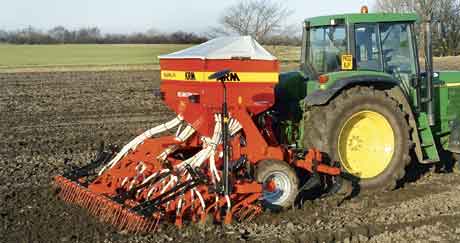
KRM Soladrill – now with a choice of three or four coulter rows – can be had with a tine cultivation toolbar permanently installed along the front…
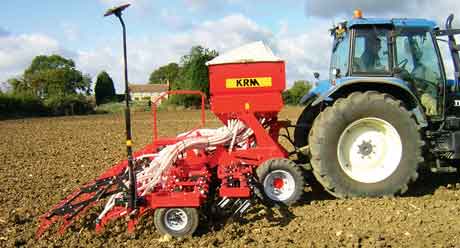
…or behind the support wheels, which allows simple pto fan drive to be retained and keeps the hopper weight well forward
This can be installed either along the front of the drill, as per the manufacturer’s original layout, with hydraulic in place of pto drive to the seed distribution fan or beneath the hopper, between the depth wheels and coulters.
This integrated configuration, says Mr Rennie, allows pto drive to the fan to be retained and keeps the weight concentrated in the hopper and around the headstock as close to the tractor as on the plain version.
Whether the three- or four-row version is chosen, the coulter arms are all of the same length to give consistent penetration pressure and contour following.
“The geometry is such that movement at the spring, which lies beneath the coulter arm, is very small compared with any movement at the coulter tip,” notes Mr Rennie. “That results in consistent pressure on the reversible point, which is set vertically to open an even furrow for the seed.”
A similar coil spring mechanism keeps the cultivator tines in place while allowing some movement for protection against stone damage. The “C” tines are arranged in staggered formation by being alternately attached to the front and back face of the toolbar.
A two-row finger tine harrow follows to level the resulting tilth ahead of the coulters, with a two-row coil tine harrow completing the four-stage process.

